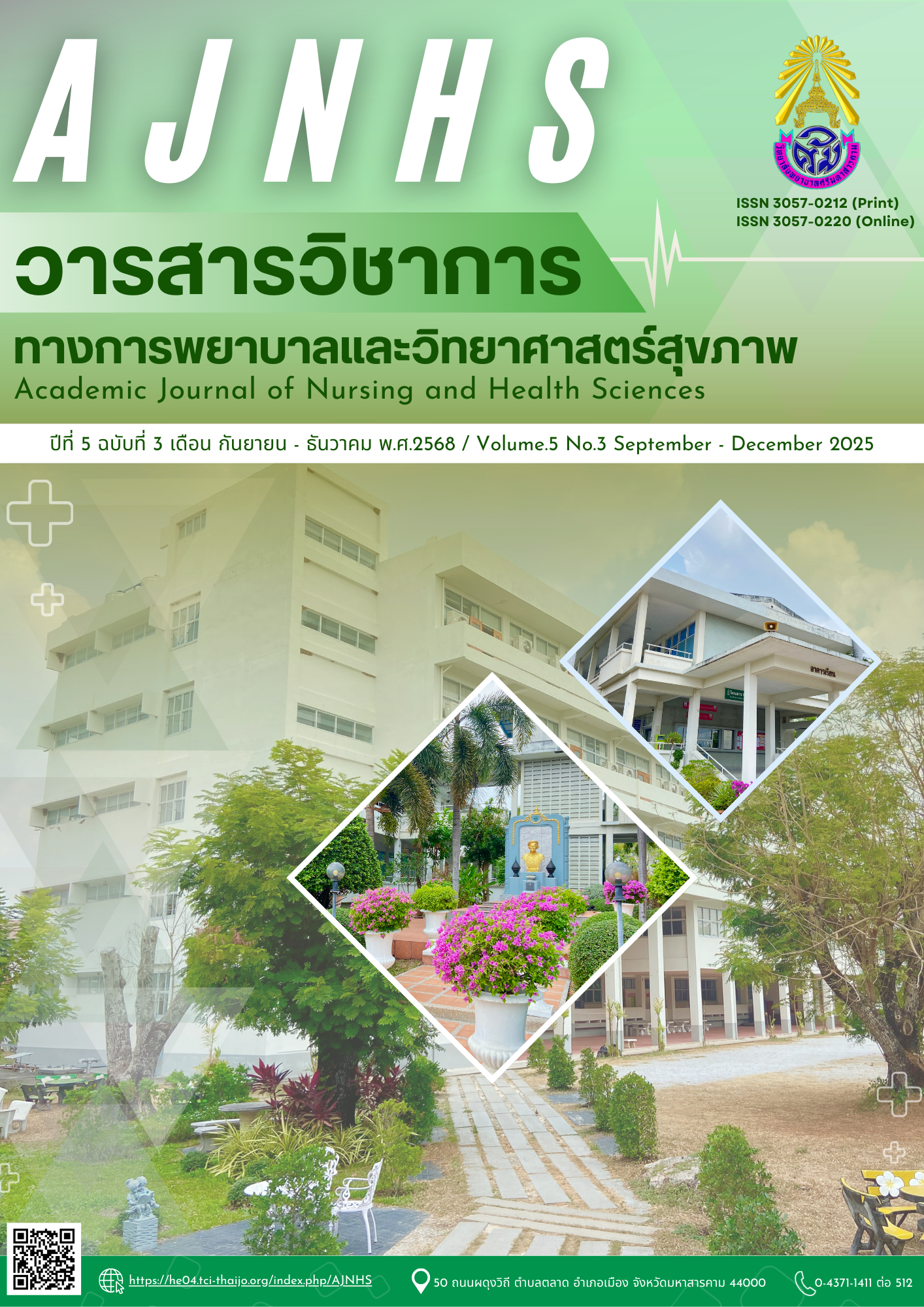Development of a Pulmonary Tuberculosis Screening Model at Nadun Hospital
Keywords:
Pulmonary tuberculosis, Screening, Model developmentAbstract
Objective: This action research aimed to develop a screening model for pulmonary tuberculosis patients and evaluate the outcomes of implementing the developed screening model at Nadoon Hospital.
Methods: The study was conducted from October 2023 to July 2024 using a four-phase action research approach: planning, implementation, monitoring and evaluation, and reflection. The sample consisted of 17 multidisciplinary healthcare personnel and 68 suspected pulmonary tuberculosis patients. Research instruments included a knowledge assessment form, in-depth interview guidelines, and a satisfaction evaluation form. Quantitative data were analyzed using descriptive statistics and Wilcoxon Signed-Rank Test, while qualitative data were analyzed using content analysis.
Results: The developed screening model comprised six approaches: (1) assigning nurses to manage screening points, (2) assigning nurses to manage respiratory disease clinics, (3) managing patients with fever, cough, and sneezing by having them wait separately at the respiratory disease clinic, (4) using pulmonary tuberculosis screening forms, (5) establishing fast-track referral channels for suspected pulmonary tuberculosis patients, (6) enhancing communication systems. The post-development model demonstrated greater comprehensiveness, improved patient risk stratification, reduced overcrowding in tuberculosis clinics, and increased COVID-19 testing. Healthcare personnel's mean knowledge scores significantly increased from 12.53 to 15.71 (P < 0.001). Healthcare personnel expressed high satisfaction with the screening system ( = 3.97).
Conclusion: The development of a pulmonary tuberculosis screening model through action research significantly improved screening efficiency, enhanced healthcare personnel's knowledge and understanding, and generated high satisfaction among both healthcare providers and patients. The developed model can be adapted for implementation in similar healthcare facilities.
References
กรมควบคุมโรค. (2564). คู่มือการป้องกันและควบคุมวัณโรค. โรงพิมพ์ชุมนุมสหกรณ์การเกษตรแห่งประเทศไทย.
กรมควบคุมโรค. (2567). รายงานสถานการณ์วัณโรคประเทศไทย ประจำปี 2566. กระทรวงสาธารณสุข.
จันทร์เพ็ญ โฮมหงส์, สุชาดา ทองคำ, และ วิไลพร สุขเกษม. (2564). การพัฒนาเครื่องมือวัดคุณภาพ.การบริการสุขภาพ. วารสารพยาบาลศาสตร์, 39(2), 45-58.
โรงพยาบาลนาดูน. (2566). รายงานประจำปี 2566. สำนักงานสาธารณสุขจังหวัดมหาสารคาม.
บุญชม ศรีสะอาด. (2545). การวิจัยเบื้องต้น (พิมพ์ครั้งที่ 7). สุวีริยาสาส์น.
Anderson, L. W., & Krathwohl, D. R. (Eds.). (2001). A taxonomy for learning, teaching, and assessing: A revision of Bloom’s taxonomy of educational objectives. New York :Longman.
Deci, E. L., & Ryan, R. M. (2000). The "what" and "why" of goal pursuits: Human needs and the self-determination of behavior. Psychological Inquiry, 11(4), 227-268. https://doi.org/10.1207/S15327965PLI1104_01
Institute of Medicine. (2001). Crossing the quality chasm: A new health system for the 21st century. National Academy Press.
Jensen, P. A., Lambert, L. A., Iademarco, M. F., & Ridzon, R. (2005). Guidelines for preventing the transmission of Mycobacterium tuberculosis in health-care settings, 2005. MMWR Recommendations and Reports, 54(RR-17), 1-141.
Kemmis, S., & McTaggart, R. (1988). The action research planner (3rd ed.). Deakin University Press.
Kirkpatrick, D., & Kirkpatrick, J. (2016). Evaluating training programs: The four levels (4th ed.).Berrett-Koehler Publishers.
Moen, R., & Norman, C. (2019). The history of the PDCA cycle. Quality Progress, 52(7), 40-47.Sagbakken, M., Frich, J. C., & Bjune, G. (2008). Barriers and enablers in the management of tuberculosis treatment in Addis Ababa, Ethiopia: A qualitative study. BMC Public Health, 8, 11. https://doi.org/10.1186/1471-2458-8-11
Ulrich, R. (1984). View through a window may influence recovery from surgery. Science, 224(4647), 420-421.
https://doi.org/10.1126/science.6143402
Woldehanna, S., & Volmink, J. (2010). Treatment of latent tuberculosis infection in HIV infected persons. Cochrane Database of Systematic Reviews, (1), CD000171. https://doi.org/10.1002/14651858.CD000171.pub3
World Health Organization. (2015). The End TB Strategy. WHO Press.
World Health Organization. (2019). WHO guidelines on tuberculosis infection prevention and control: 2019 update. WHO Press.
World Health Organization. (2023). Global tuberculosis report 2023. WHO Press.
Downloads
Published
How to Cite
Issue
Section
License

This work is licensed under a Creative Commons Attribution-NonCommercial-NoDerivatives 4.0 International License.


